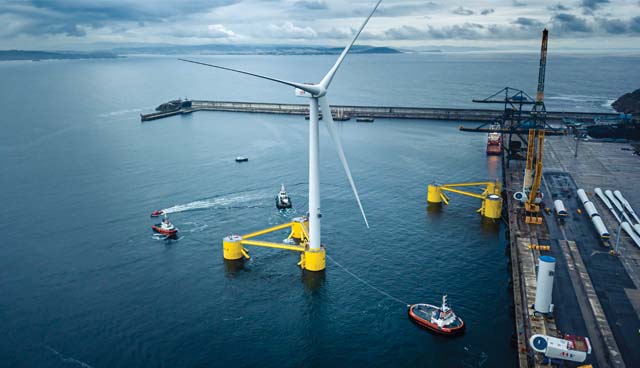Ireland moves closer to first offshore auction
9 March 2022TEN-E Regulation: No longer oceans apart
9 March 2022Time running out for offshore wind targets
By the end of 2022, we will know whether the Government’s target of 5,000MW of offshore wind energy by the end of 2030 is achievable, writes Noel Cunniffe, CEO of Wind Energy Ireland.
It is clear that, right now, we are not on track and that the emissions savings required from offshore wind in the proposed carbon budgets are unlikely to materialise.
There has been progress. The National Marine Planning Framework is complete. The Maritime Area Planning Act was passed by the Oireachtas just before Christmas. The model for our offshore electricity grid has been identified.
But this does not change the fact that we are losing time and that, today, we are less likely to hit our 2030 target than we were when the original Climate Action Plan was published.
The reality remains that the relevant government departments and state agencies responsible for enabling the development of offshore wind energy are chronically short of staff and resources while our industry is increasingly short of time.
The passage of the Maritime Area Planning Act was a significant achievement but it is still true that, based on the conversations I have every week with companies in the international supply chain, there is diminishing confidence that Ireland’s 2030 targets are achievable.
The concerns being highlighted by our members typically focus on two key areas which we must get right: grid and planning.
Electricity grid
Our Phase One projects, which we hope to see connected in 2027-2028, urgently need certainty on how the grid connection process will work and the timelines that will be involved. The policy eventually implemented by the CRU must be clear and legally robust.
Our members have a wealth of experience in this area from markets all over Europe. EirGrid should work closely with industry and use this experience to ensure we can construct and connect these projects as efficiently and as cost-effectively as possible, ultimately bringing the best value to the consumer.
It is also important for EirGrid to work closely with our members as they update the Shaping Our Electricity Future strategy, which was published last year. While it is a step in the right direction, this will not deliver the grid infrastructure we will need to cut carbon emissions as required by the Climate Change Advisory Council nor to deliver a net-zero electricity system by 2035.
We cannot decarbonise our electricity supply without delivering the projects EirGrid has announced and supporting them is a litmus test that will tell us who in Ireland is serious about tackling climate change. But we need to go further and particularly identify how we can strengthen the grid on the south and west coast.
While the Phase One projects are the priority, we must design a grid for the next generation of projects and particularly for the floating wind projects which have the potential to make Ireland a renewable energy superpower.

Credit: Photo courtesy of Principle Power. Artist: DOCK90.
Planning system
As we focus our efforts on ensuring we have an electricity grid fit for purpose we must also create a planning system that can process enough applications over the next four years to ensure competitive auctions and, ultimately, 5,000MW of wind power.
Those of our members who struggle to get onshore projects through the Irish planning system are understandably nervous when they consider the challenge of getting far larger and more complex projects through a system that often appears designed to prevent, rather than to enable, development.
The Maritime Area Planning Act provides a good start, but we need to ensure that the secondary legislation and the offshore planning guidelines which will come from the Act provide our projects with a level of post-consent flexibility that makes it practical to develop offshore wind farms in Ireland.
If our members are obliged, once planning permission has been obtained, to submit a new consent application every time a turbine needs to be moved a few metres or a cable route amended, then these projects will very quickly grind to a halt as planning authorities are overwhelmed.
There is also the potential for decisions to be challenged at every stage by means of judicial reviews. People are entitled to justice and to participate in the planning process, but we cannot afford for projects to be delayed for years in the courts.
That is why it is so important to ensure that industry – and government – is confident that An Bord Pleanála has the expertise and the budget to deal with a coming rush of applications for some of the biggest and most complex infrastructure projects we will build in Ireland.
That confidence is not in industry today and its absence is particularly worrying when contracts under the first Offshore Renewable Electricity Support Scheme auction will be awarded before planning permission is confirmed.
Overcoming challenges
These are big challenges, but they can be overcome. We know the target can still be achieved, but these projects will take time to build, and time is something we are fast running out of.
For us to deliver we need a much stronger electricity grid, a clear process for connecting projects and a planning system that makes delivery possible.
We will only see this if essential resources are invested in critical government departments and State agencies like An Bord Pleanála, National Parks and Wildlife Service, EirGrid, ESB Networks and the CRU to enable them, to empower us, to deliver the target set in the Programme for Government.
Together, we can – we must – connect the huge volumes of offshore wind energy that can decarbonise our electricity system and set us on the path to true energy independence.
E: office@windenergyireland.com
W: windenergyireland.com

